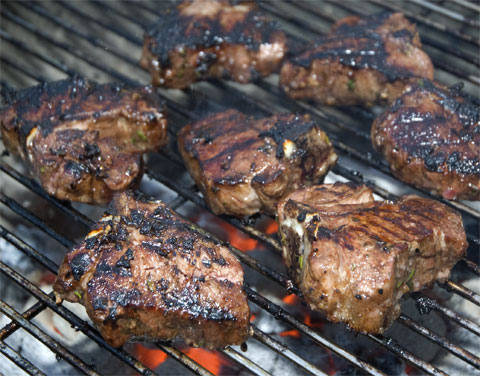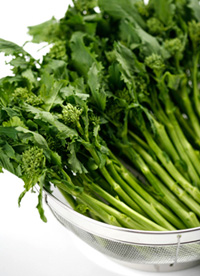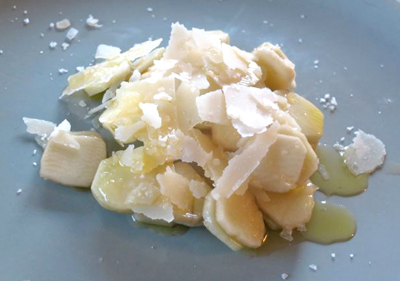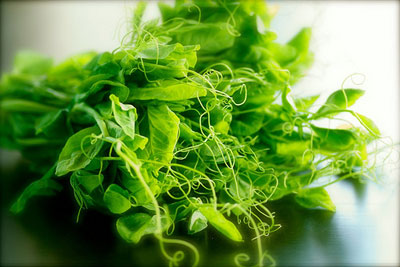"Just a little sheep dip. Panacea for all stomach ailments." Mae West
 If you say you don't like lamb, you probably really mean you don't like the preparation of lamb you were served. If you have never savored the rich, tender, beefy (never gamey) flavor of a lamb loin chop, you are missing what I consider to be the best nugget of red meat in the world. Period. Really. No cow.
If you say you don't like lamb, you probably really mean you don't like the preparation of lamb you were served. If you have never savored the rich, tender, beefy (never gamey) flavor of a lamb loin chop, you are missing what I consider to be the best nugget of red meat in the world. Period. Really. No cow.
Loin chops are the porterhouse steaks of the lamb, with a T-bone separating the strip steak on one side and the filet mignon on the other. But they are a lot smaller than beef porterhouses. The best, cut 1.5 to 2" thick, are no bigger than a child's fist.
Lamb is a traditional spring dish, and this recipe uses an extremely quick and easy marinade and cooking technique. The marinade, I call it my Sheep Dip, is great on all cuts of lamb including rack, leg, and kabobs. If you don't think you like lamb, try this and you may swear off beef for life. The output is amazingly flavorful and tender and juicy and succulent and...

 Summer is fast approaching and more and more fruits and vegetables are coming in season. One of my favorite spring/summer crossover vegetables is rhubarb. I love it's tart flavor and bright pink color. It complements a variety of sweet and savory dishes. But it's most commonly known as pie fruit and is more often paired with strawberries than with any other fruit or vegetable. But I like it when it plays the leading role in a dish and not the supporting one.
Summer is fast approaching and more and more fruits and vegetables are coming in season. One of my favorite spring/summer crossover vegetables is rhubarb. I love it's tart flavor and bright pink color. It complements a variety of sweet and savory dishes. But it's most commonly known as pie fruit and is more often paired with strawberries than with any other fruit or vegetable. But I like it when it plays the leading role in a dish and not the supporting one. I know there are other things to do with rapini but I am stuck in a happy rut. I always eat it exactly the same way. Rapini also called broccoli rabe looks like a leafy miniature broccoli and has a slight bitterness to it that marries well with the richness of Italian sausage. Toss that combination with a little onion, garlic, chili flakes and pasta and you're in business.
I know there are other things to do with rapini but I am stuck in a happy rut. I always eat it exactly the same way. Rapini also called broccoli rabe looks like a leafy miniature broccoli and has a slight bitterness to it that marries well with the richness of Italian sausage. Toss that combination with a little onion, garlic, chili flakes and pasta and you're in business.  People say we don’t have seasons in LA. Oh but we do my friends, we do. For example, now is Artichoke Season, a time when (if you’re lucky) you can find a farmer harvesting huge heavy artichokes with a long stem still attached. The artichoke head that we eat is the bud stage of a giant gorgeous purple flower. As the artichoke ages the “leaves” of the bud open ultimately revealing the choke which turns deep lavender. For eating you want the bud pretty tightly closed. And look for heavy artichokes. Heaviness means freshness. When the artichoke is freshly cut it’s cells are full of water. As time goes by the water transpires and evaporates leaving the vegetable light and dry.
People say we don’t have seasons in LA. Oh but we do my friends, we do. For example, now is Artichoke Season, a time when (if you’re lucky) you can find a farmer harvesting huge heavy artichokes with a long stem still attached. The artichoke head that we eat is the bud stage of a giant gorgeous purple flower. As the artichoke ages the “leaves” of the bud open ultimately revealing the choke which turns deep lavender. For eating you want the bud pretty tightly closed. And look for heavy artichokes. Heaviness means freshness. When the artichoke is freshly cut it’s cells are full of water. As time goes by the water transpires and evaporates leaving the vegetable light and dry. A couple of weeks ago I experienced a revelation: I tasted my first pea shoot.
A couple of weeks ago I experienced a revelation: I tasted my first pea shoot.
